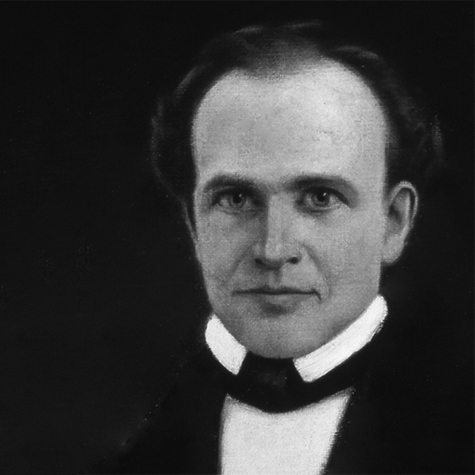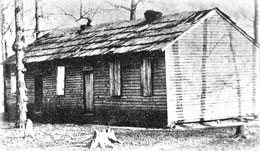
The Berea Story
The startled railroad surveyor dropped his notebook as his surveying instrument focused on a brick structure extending above the forest canopy.
Ladies Hall, Berea College’s first brick building, seemed totally out of place in the woodland setting.
“Whoever put up that building in this wilderness must have had faith,” the surveyor observed.
The surveyor’s experience came some 20 years after the Rev. John G. Fee started a one-room school in 1855 that eventually would become Berea College. Fee, a native of Bracken County, Ky., was a scholar of strong moral character, dedication, determination and great faith. He believed in a school that would be an advocate of equality and excellence in education for men and women of all races.
Fee’s uncompromising faith and courage in preaching against slavery attracted the attention of Cassius M. Clay, a well-to-do Kentucky landowner and prominent leader in the movement for gradual emancipation. Clay felt he had found in Fee an individual who would take a strong stand on slavery.
In 1853, Clay offered Fee a 10-acre homestead on the edge of the mountains if Fee would take up permanent residence there. Fee accepted and established an anti-slavery church with 13 members on a ridge they named “Berea” after the biblical town whose populace was open-minded and receptive to the gospel (Acts 17:10).

Cassius M. Clay
In 1854, Fee built his home upon the ridge. In 1855, a one-room school, which also served as a church on Sundays, was built on a lot contributed by a neighbor. Berea’s first teachers were recruited from Oberlin College, an anti-slavery stronghold in Ohio. Fee saw his humble church-school as the beginning of a sister institution “which would be to Kentucky what Oberlin is to Ohio, anti-slavery, anti-caste, anti-rum, anti-sin.” A few months later, Fee wrote in a letter, “we…eventually look to a college — giving an education to all colors, classes, cheap and thorough.”
Fee worked with other community leaders to develop a constitution for the new school, which he and Principal J. A. R. Rogers insisted should ensure its interracial character. It also was agreed that the school would furnish work for as many students as possible, in order to help them pay their expenses and to dignify labor at a time when manual labor and slavery tended to be synonymous in the South.
The first articles of incorporation for Berea College were adopted in 1859. But that also was the year Fee and the Berea teachers were driven from Madison County by Southern pro-slavery sympathizers. Fee spent the Civil War years raising funds for the school; in 1865, he and his followers returned. A year later, the articles of incorporation were recorded at the county seat, and in 1869 the college department became a reality.
The first catalog, issued for 1866-67, used the corporate name “Berea College,” but the title “Berea Literary Institute” was printed on the cover because it was thought to convey better “the present character of the school.” Enrollment that academic year totaled 187 — 96 black students and 91 whites. For several decades following the Civil War, Berea’s student body continued to be divided equally between white and black students, many of whom went on to teach in schools established solely for African-Americans.
In 1886-87, the school had three divisions: Primary, Intermediate and Academic. Students could pursue a college preparatory course, a shorter course, or a teachers’ course. In 1869-70, five freshmen were admitted to the College Department, and in 1873 the first bachelor’s degrees were granted.
Berea’s commitment to interracial education was overturned in 1904 by the Kentucky Legislature’s passage of the Day Law, which prohibited education of black and white students together. When the U.S. Supreme Court upheld the Day Law, Berea set aside funds to assist in the establishment of Lincoln Institute, a school located near Louisville, for black students. When the Day Law was amended in 1950 to allow integration above the high school level, Berea was the first college in Kentucky to reopen its doors to black students.
By 1911, the number of students seeking admission to Berea was so great that the trustees amended the College’s constitution to specify the southern mountain region as Berea’s special field of service. The commitment to Appalachia, however, began as early as 1858 when Rogers, after a trip through the mountains, identified the region as a “neglected part of the country” for which Berea was founded to serve.
Curricular offerings have varied at Berea to meet changing needs. In the early 1920s, in addition to its College Department, Berea had a high school that included ungraded classes for students who had not had educational opportunities, an elementary school, a vocational school and a Normal School for teacher training. Although the general mission of serving students with financial need continued, units and divisions were reorganized through the years. In 1968, Berea discontinued its elementary and secondary programs and now focuses entirely on undergraduate college education.

The First Berea College Building
Berea’s distinctive commitments and educational programs have brought the College national recognition. Above all, the excellence of Berea’s academic program earns acclaim.
U.S. News & World Report has repeatedly named Berea the No. 1 regional college in the South, The New York Times, The Chronicle of Higher Education, The Philadelphia Inquirer, The Times of London, and the “Solutions” segment of ABC World News have focused national and international attention on many aspects of the contemporary Berea experience. Full-tuition scholarships provided to all students, the effectiveness of the work program and students’ involvement in community service projects are among the features highlighted. Such reports are expected to continue as Berea alumni distinguish themselves in all walks of life and in many parts of the world.
Fee was the first president of Berea’s Board of Trustees, serving from 1858-92, and Rogers was the first principal, 1858-69. The first Berea College president was appointed in 1869. Since then there have been nine presidents:
-
- Edward Henry Fairchild, 1869-89
- William B. Stewart, 1890-92
- William Goodell Frost, 1892-1920
- William J. Hutchins, 1920-39
- Francis S. Hutchins, 1939-67
- Willis D. Weatherford, 1967-84
- John B. Stephenson, 1984-94
- Larry D. Shinn, 1994-2012
- Lyle D. Roelofs, 2012-